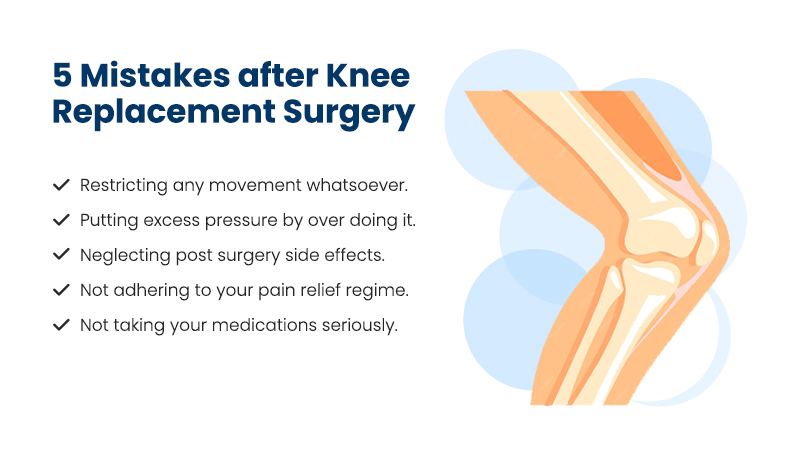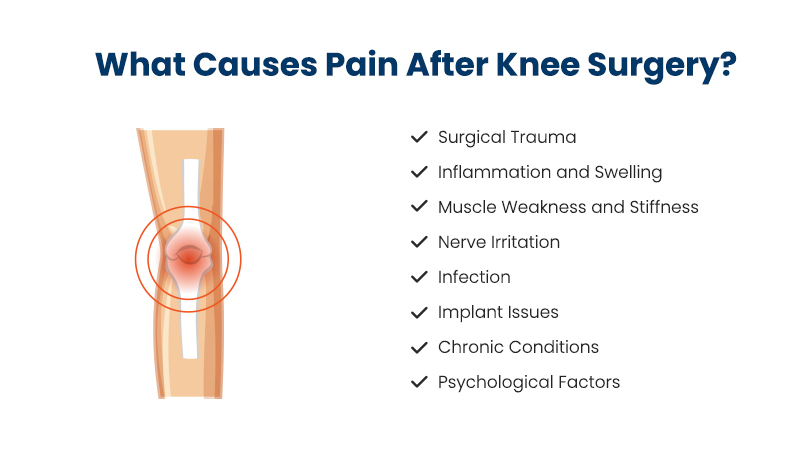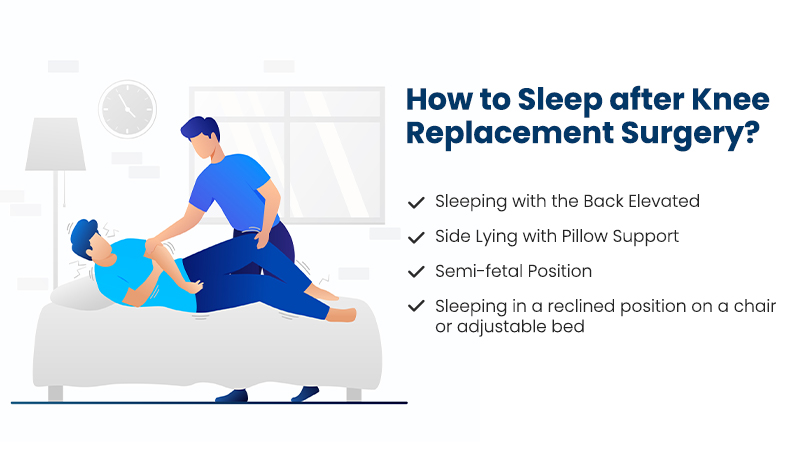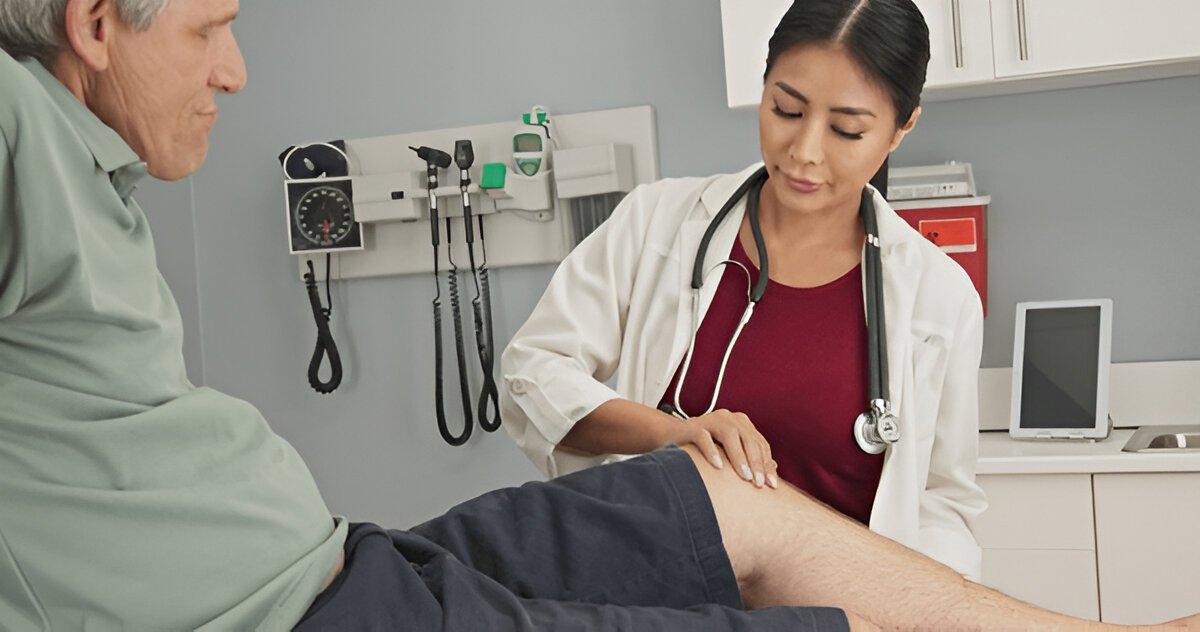Knee replacement surgery is a frequent technique that can significantly enhance a person's quality of life by lowering pain and boosting mobility. But to get the most out of the operation, there are a few things you should not do when you're recovering.
Regrettably, many people make basic errors following a knee replacement that might impede their recovery and postpone their return to normal activities. These are the top five mistakes one should never make after knee replacement. We will review each in detail and discover ways to prevent them so you can heal effectively and quickly.
What are the 5 Mistakes after Knee Replacement Surgery?
Now, let's get started! For those with severe arthritis, knee replacement surgery is a very beneficial treatment that significantly reduces pain and improves knee function. However, appropriate aftercare is essential for the most significant results.
Unfortunately, many patients' whole knee replacement recovery time extends as they tend to make preventable errors that impede recovery. The top five mistakes to avoid are as follows:
- Restricting any movement whatsoever
- Putting excess pressure by overdoing it
- Neglecting post-surgery side effects
- Not adhering to your pain relief regime
- Not taking your medications seriously
To reduce your knee replacement recovery time, this is what you should commit to memory and start acting on it:
- Mild motion, little and frequently
- Observe your body and take breaks as necessary.
- Steer clear of high-risk activities weeks after surgery for a knee replacement.
- Watch out for warning signs and seek professional assistance.
- Follow your pain management strategy.
- Accept assistance from loved ones, friends, and medical professionals as required.

Now let’s discuss these problems at length so that you know what not to do during knee replacement recovery:
1. Restricting any movement whatsoever
Being wary and nervous about moving your newly repaired knee following surgery seems sensible. However, restricting any movement whatsoever can be counterproductive to your knee replacement recovery expectations.
You must follow your doctor's advice and begin with simple movements and activities as soon as permitted. This helps to reduce stiffness, improve blood circulation, and encourage healing. As your knee strengthens, you may progressively increase the length and intensity of your workouts.
2. Putting excess pressure by overdoing it
Some patients tend to overdo things after their knees are replaced. This might damage the newly developed knee joint. You must follow your physical therapist's modest, gradual exercise program. Refrain from attempting to take on too much too soon, as this might hinder your recovery and increase the likelihood of issues.
What is considered overexertion?
- Driving after a knee replacement
- Going back to work too soon
- Engaging in high-risk activities (weighted lifting or twisting movements)
- Sudden pain after a period
- Instability
- Pain worsens in the days following surgery
- Elevated knee pain, swelling, and heat
- Heat, swelling, and pain in your calf
3. Neglecting post-surgery side effects
One of the main treatments for knee replacement surgery is pain, swelling, and bruising. These side effects are a typical component of the healing process and may last for a few weeks or even months.
However, ignoring and not telling your doctor about these side effects might be dangerous. Asking for assistance shouldn't be a sign of weakness; your physician can provide medication and other treatments to help you cope with these side effects.
4. Not adhering to your pain relief regime
To assist you in managing the agony that often follows knee replacement surgery, your doctor may likely prescribe pain medication. However, some people tend to forget to take their medication or stop taking it entirely after the discomfort subsides.
This may have been a mistake since pain can resurface suddenly and be difficult to manage. You must adhere to your doctor's prescribed pain management plan to ensure a speedier recovery.
5. Not taking your medications seriously
Your doctor may also prescribe blood thinners, antibiotics, and analgesics to help prevent blood clots and infections after surgery. You must take these drugs precisely as prescribed and without missing any doses. These drugs are required to avoid significant issues and to encourage a full recovery.
What Causes Pain After Knee Surgery?
Here are some potential causes of pain after surgery:
1. Surgical Trauma
Knee replacement surgery removes diseased bone and cartilage. Over time, surgical operations improve, but injury to the tissue can still be inevitable. As a result, pain follows each replacement surgery.
2. Inflammation and Swelling
In addition, inflammation is the body's natural reaction to the surgery. It can cause swelling and discomfort in the knee joint. Though the degree of inflammation is necessary for recovery, it may aggravate pain at the first stages.
3. Muscle Weakness and Stiffness
Moreover, the muscles around the knee may weaken and become stiff due to less use during recovery. Insufficiently firm muscles may cause pain when moving because they do not provide enough support for the joint.

4. Nerve Irritation
In addition, while operating, the nerves around the knee may become inflamed or compressed. This is sometimes called radiating pain since it may cause discomfort down the leg.
5. Infection
Infection is a rare but potentially fatal side consequence of partial knee surgery. Symptoms include discomfort, surgical site inflammation, warmth, reddening, and fever. One should see their surgeon or doctor immediately if an infection is discovered.
6. Implant Issues
Pain may also arise due to factors related to the knee implant post-surgery. Inadequate position, loosening or loss of the knee implant, and instability can all cause this kind of pain. Some fixations may necessitate revision surgery.
7. Chronic Conditions
Following knee replacement surgery, patients with pre-existing diseases such as osteoporosis or arthritis may continue to have discomfort. Even while the procedure can significantly reduce pain, not all causes of discomfort may be eliminated.
8. Psychological Factors
Psychological conditions, including anxiety, despair, or motion sickness, may impact a person's sense of pain. Using relaxation methods or therapy to address these issues can help control discomfort following surgery.
How long does it Take to Recover from a Knee Surgery?
The journey of knee replacement surgery and recovery time can be taxing. Patients often require many weeks to months to achieve a complete range of motion. The worst day after knee replacement surgery is usually within the first few days when pain and swelling peak.
Nonetheless, most patients see a noticeable improvement in their knee function as their rehabilitation continues. Typically, the healing time for total knee replacement ranges from about three to six months, although individual experiences may vary. Patients must carefully adhere to their surgeon's post-operative recommendations to ensure a speedy recovery.
Best Pillow and Sleep Positions After a Knee Replacement
Sleeping after a knee replacement may be challenging due to pain and swelling. Here are a few tips for sleeping positions and pillow options that may assist:
Sleeping with the Back Elevated
You can slide a pillow under the operated knee, which should be slightly above the level. This prevents swelling and pain. Another pillow can be placed to support the head and neck.
Side Lying with Pillow Support
If lying on the side is your most comfortable position, place a pillow between the knees to maintain alignment. This will lessen the strain on the operated-on knee. You may also put a small pillow or rolled towel under the operated knee to make it more supportive.
Semi-fetal Position
Lying on your back with a pillow under your head and another under your operated knee, slightly bend your non-operated knee and allow a pillow to sit between your knees. This position can relieve some pressure on your knees and your back.
Sleeping in a reclined position on a chair or adjustable bed
If lying flat is uncomfortable, you may sleep in a reclined position in a comfortable chair or an adjustable bed. Support your operated knee with pillows to keep it elevated.

What type of pillow should you use?
Knee Pillow
When lying on your side, use a knee or regular pillow as a cushion to maintain the correct alignment of your knees. Use a knee pillow designed or specially created to support your knees.
Cervical pillow
Cervical Pillows help to support the neck and head and keep the spine in perfect alignment.
Wedge Pillow
This can be useful if you want to sleep more upright. The wedge supports the back and legs, reducing pressure on the knees.
Body Pillow
A body pillow can be applied to many sleep stances. You can put it between your knees in the side-lying position or elevate your legs in the supine position.
Conclusion
The benefits of a successful knee replacement operation are immense. It dramatically impacts pain reduction and improved mobility, ultimately leading to a better quality of life. However, for a proper recovery, you should avoid making mistakes like people do by not being too stiff and moving to exercise if you experience the surgery's side effects. Some issues might go wrong without even knowing about them.
Understanding the possible causes of post-knee surgery pain would entail recognizing a variety of factors including surgical trauma, inflammation, weakness caused by muscle abnormalities, or irritation from nerves, even those unrelated to physical health, such as psychological influences — that could be responsible. Stay informed by researching online, including watching a helpful knee replacement surgery video.
Recovery from knee surgery typically lasts three to six months and requires patient adherence more than anything else. Be proactive throughout this period (following your surgeon's guidance) because positive outcomes greatly influence overall well-being.













